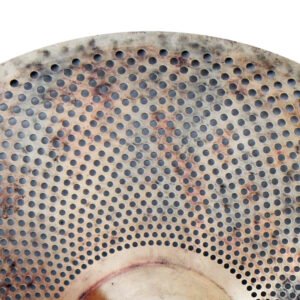Whether you’re performing in an orchestra, marching in a band, or practicing at home, mastering the proper technique for holding crash cymbals is vital for both sound quality and player safety. Your grip, stance, and positioning will directly impact your ability to create crisp crashes and controlled dynamics. While the basic concept seems straightforward, there’s more to handling these percussion instruments than meets the eye—and getting it right can transform your performance from amateur to professional.
Key Takeaways
Position your hands through leather strap handles with thumbs on top and fingers wrapped securely underneath.
Keep cymbals at a 45-degree angle with edges tilted away from each other.
Maintain elbows close to body and stand with feet shoulder-width apart for stability.
Hold cymbals between chest and shoulder height with a natural 90-degree bend in elbows.
Grip tightly during impact but release tension afterward to prevent strain and maintain control.
Essential Equipment and Cymbal Care

Two main items are essential for playing crash cymbals: matched pairs of orchestral crash cymbals and protective straps. When making your cymbal selection, look for pairs that produce clear, bright tones and complement each other acoustically. Choose cymbals between 16-20 inches in diameter for standard orchestral use, ensuring they’re well-matched in size and weight.
Your straps should be made of durable leather or heavy-duty fabric, featuring a center hole that fits snugly around the cymbal’s cup. Install them properly by threading through the center hole and securing with strong knots.
Maintain your cymbals using proper cleaning techniques. Wipe them with a soft, dry cloth after each use to remove fingerprints and dust. For deeper cleaning, use specialized cymbal cleaner and avoid harsh chemicals. Store your cymbals in padded cases when not in use, keeping them away from extreme temperatures and humidity.
Basic Grip Techniques
While proper equipment is essential, mastering the basic grip is fundamental to playing crash cymbals effectively. Position your hands at the leather strap handles, keeping your thumbs on top and ensuring your fingers wrap securely underneath. Your grip should be firm but relaxed to maintain control while allowing the cymbals to resonate properly.
| Grip Element | Correct Position |
|---|---|
| Thumb | Top of strap handle |
| Fingers | Wrapped underneath |
| Wrist | Flexible, not locked |
Maintain a 45-degree cymbal angle when preparing to crash, with the edges slightly tilted away from each other. Your elbows should stay close to your body, creating a stable foundation for controlled movements. As you develop your basic stick grip technique, focus on consistent positioning and balanced weight distribution between both hands. This foundation will enable precise articulation and help prevent unwanted wobbling or misaligned strikes during performance.
Proper Stance and Positioning
The foundation of effective crash cymbal playing extends beyond grip to encompass your body’s overall positioning. Stand with your feet shoulder-width apart, keeping your weight evenly distributed and your knees slightly flexed for ideal stability and mobility.
Position yourself so that your crash cymbal height falls between your chest and shoulders when held at the ready position. Your elbows should maintain a natural, relaxed bend at approximately 90 degrees. You’ll want to establish comfortable foot positioning that allows you to pivot and shift your weight smoothly during performance.
Keep your back straight but not rigid, and your shoulders relaxed to prevent tension from building up during extended playing sessions. Your head should remain level, with your eyes forward or slightly downward to maintain visual contact with your conductor or sheet music. This balanced stance enables quick, controlled movements while protecting against strain and fatigue.
Playing Dynamics and Sound Control
To control crash cymbal dynamics, you’ll need to master both soft and loud playing techniques through precise grip adjustments. Your volume control depends primarily on the pressure applied between the cymbals and the angle at which you bring them together. When ending a crash, you can manipulate the sound’s duration by either letting the cymbals ring freely or muting them against your chest or stomach.
Soft Vs Loud Techniques
Playing crash cymbals with dynamic control requires mastering both soft and loud techniques. For soft striking, hold the cymbals at a 45-degree angle and gently bring them together using minimal arm movement. Focus on controlled release to prevent unwanted overtones. When executing loud accents, extend your arms fully and use more forceful movements, ensuring the cymbals connect squarely for maximum projection.
To achieve dynamic contrast, vary your striking force while maintaining consistent sound articulation. For expressive playing, adjust the angle and speed of contact – smaller angles produce softer sounds, while wider angles create bolder crashes. You’ll need to practice shifting between these techniques smoothly, keeping your grip firm but relaxed to maintain control over both subtle and powerful cymbal strikes.
Control Volume Through Grip
Mastering volume control through proper grip technique requires understanding the relationship between hand pressure and cymbal resonance. Your grip pressure directly affects dynamic control and sound projection when playing crash cymbals.
- Apply firm pressure with your thumb and first two fingers when gripping the leather strap to achieve maximum control during forte passages
- Loosen your grip slightly while maintaining stability for piano sections, allowing the cymbals to resonate more freely
- Adjust your grip pressure gradually between strikes to create smooth dynamic shifts without losing control
- Keep your wrist relaxed but stable, letting your grip pressure do the work rather than arm tension
These grip adjustments will help you achieve precise dynamic control while maintaining consistent sound quality across all volume levels.
Muting and Sound Duration
When performing with crash cymbals, proper muting technique becomes essential for controlling sound duration and achieving precise dynamic effects. To mute the cymbals, press them firmly against your chest or stomach immediately after the crash, using your body as a dampening surface. You’ll need to experiment with different muting techniques to find what works best for specific musical passages.
For sound shaping, you can vary the duration by adjusting how quickly you mute after the initial crash. A delayed mute allows the sound to ring longer, while immediate muting creates a shorter, more staccato effect. In orchestral settings, watch your conductor closely for cues on exact muting timing. Remember that effective muting requires consistent pressure to avoid unwanted rattling or secondary vibrations.
Common Striking Methods
To create distinct sounds with crash cymbals, you’ll need to master three primary striking methods: straight-on, glancing, and brushing. Each technique requires specific striking angles and cymbal placement to achieve the desired effect.
- Straight-on strikes produce the boldest, most dramatic sound. Position the cymbals parallel to each other and bring them together with equal force at a 90-degree angle.
- Glancing strikes create a softer, more controlled sound. Angle one cymbal slightly and strike it against the other at roughly 45 degrees, allowing them to slide past each other.
- Brushing generates a sustained, shimmering effect. Hold one cymbal stationary while lightly scraping the edge of the other across its surface.
- Combined techniques allow for dynamic expression. You can shift between methods during a single piece, varying the intensity and character of each strike to match the music’s requirements.
Advanced Performance Techniques
Professional crash cymbal players can elevate their performances through several sophisticated techniques that build upon basic striking methods. You’ll want to master advanced stickhandling techniques like the reverse grip and cross-hand positioning to achieve more nuanced sound control. These methods let you execute rapid shifts between different striking angles while maintaining precise cymbal alignment.
To enhance your dynamic performance expressions, practice varying the angle of attack from 15 to 45 degrees. You can create subtle timbral changes by adjusting the point of contact between the cymbals – from edge-to-edge strikes for bright, cutting sounds to face-to-face contact for warmer tones. Experiment with different release timings: quick separations produce sharp, defined crashes while delayed separations create sustained resonance. When performing crescendos, gradually increase both strike force and cymbal separation to achieve a smooth dynamic build. These techniques require extensive practice to maintain consistent tone quality across varying dynamics.
Avoiding Physical Strain and Injury
Since playing crash cymbals can put significant strain on your wrists and shoulders, proper form and technique are essential for preventing injuries. By implementing ergonomic techniques and focusing on injury prevention, you’ll protect yourself while maintaining ideal sound quality.
To avoid physical strain during crash cymbal performance, follow these key practices:
- Keep your elbows close to your body and maintain relaxed shoulders to reduce tension and prevent upper body fatigue
- Use your entire arm for movement rather than isolating your wrists, distributing the force across multiple muscle groups
- Take frequent breaks during long practice sessions and perform gentle stretching exercises for your forearms, wrists, and shoulders
- Adjust your grip pressure throughout performances – grip tightly only at the moment of impact, then immediately release excess tension
Remember to listen to your body’s signals and modify your technique if you experience any discomfort or early signs of strain.
Maintenance and Storage Best Practices
Proper care of your crash cymbals extends beyond physical technique into systematic maintenance and storage practices. Regular cymbal cleaning and proper storage solutions will guarantee longevity and consistent sound quality. Use a microfiber cloth to remove fingerprints after each use, and perform monthly deep cleaning with specialized cymbal cleaner.
| Maintenance Task | Frequency | Tools Needed |
|---|---|---|
| Surface Wiping | After Use | Microfiber Cloth |
| Deep Cleaning | Monthly | Cymbal Cleaner |
| Quality Check | Quarterly | Visual Inspection |
| Storage Prep | Daily | Protective Bags |
Store your cymbals vertically in padded cases when not in use, avoiding temperature extremes and humidity. Don’t stack them horizontally, as this can cause warping and stress points. When transporting, use dedicated cymbal bags with dividers to prevent metal-on-metal contact. Keep your storage area’s temperature between 65-75°F (18-24°C) and maintain humidity levels below 50% to prevent oxidation and material degradation.
Conclusion
As the old saying goes, “practice makes permanent,” so invest time in mastering your crash cymbal grip technique. You’ll find that proper hand positioning at the leather straps, maintaining ideal angles, and controlling your striking force will greatly enhance your performance quality. Remember to regularly check your posture, minimize tension, and implement proper care routines to guarantee both your cymbals and playing technique remain in peak condition.



